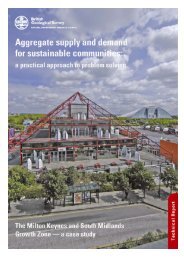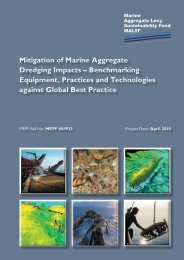creating environmental improvements through biodiversity
creating environmental improvements through biodiversity
creating environmental improvements through biodiversity
Create successful ePaper yourself
Turn your PDF publications into a flip-book with our unique Google optimized e-Paper software.
authorities, NGOs, local organisations).<br />
Impacts (Potential):<br />
The report could provide a baseline of expectation against which minerals companies, EN and other partners<br />
could assess their actions and contributions to <strong>biodiversity</strong> on minerals sites.<br />
Potential Expansion:<br />
The report was to form the basis for preparation of a practical manual for the industry, English Nature staff,<br />
local authorities and local communities<br />
Being an early publication on the issue of minerals extraction in relation to <strong>biodiversity</strong>, it is likely to need<br />
updating at some point<br />
Dissemination:<br />
Information on dissemination of this report could not be obtained.<br />
COST EFFECTIVE MULTI-PURPOSE HYDROGEOLOGICAL (OR WATER<br />
ENVIRONMENT) MONITORING FOR AGGREGATE QUARRIES (MIRO MIST<br />
CAPITA SYMONDS)<br />
– Project Proposal MA/6/1/001<br />
Sustainable Aggregates Creating Environmental Improvements <strong>through</strong> Biodiversity<br />
Project Type: Desk-based review, case studies, recommendations<br />
Site: Limited site visits<br />
Project Aim: To examine the merit of adopting a unified protocol for hydrological and hydrogeological<br />
monitoring, at least for sand and gravel sites, that would enable water quality to be monitored for ecological<br />
and archaeological conservation simultaneously<br />
Main Methods:<br />
Desk-based review of relevant previous research (published and unpublished), and policy requirements of<br />
DCLG, Environment Agency etc.<br />
Case study interviews and some limited site visits, to find out:<br />
• Which parameters have been monitored for different purposes<br />
• Usefulness of these findings<br />
• Extent to which different requirements were (or could have been) combined<br />
• Lessons that could be learned for future specification of monitoring requirements at similar sites<br />
Optional fieldwork to trial multi-purpose field monitoring<br />
Bringing this work together to develop recommendations, with particular attention on working adjacent to<br />
lowland fens, peat bogs and floodplains, as archaeological and ecological conservation objectives often share<br />
monitoring requirements here, although may require different water quality conditions<br />
Output:<br />
Concise peer-reviewed report containing recommendations on water quality monitoring for ecological and<br />
archaeological considerations (stating benefits or otherwise of a joint approach)<br />
Impacts (Potential):<br />
An integrated approach may potentially minimise the regulatory burden associated with hydrological<br />
and hydrogeological monitoring. Such an approach might represent an improvement for <strong>biodiversity</strong> in<br />
further standardising water quality monitoring – but may run the risk of over-simplifying procedures<br />
to accommodate different interests. Hopefully the project would itself highlight this drawback if it was<br />
encountered.<br />
53

















